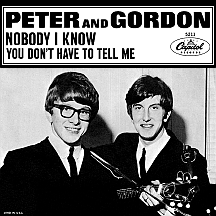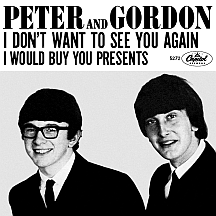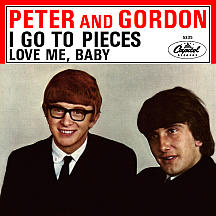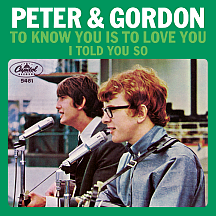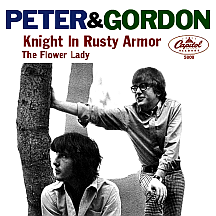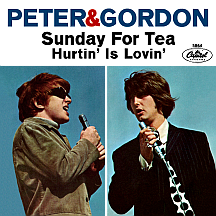PETER AND GORDON
The spring of 1964 commenced in the midst of the invasion. Stylishly-suited blighters armed with guitars and drumsticks were sending America's youth to the brink of abandoning their home-grown music heroes in favor of this Merseybeat movement from the British Isles. While every top-selling singing act that made an impact in the west owed a debt of gratitude to The Beatles, who'd inadvertently sparked the continental expansion, there were a handful who had more of a direct connection to that lovable rascal Ringo and his three fab frontmen, two of whom offered songs they'd written to these affiliated acts, usually (but not always) through a common association with Brian Epstein, who kept his plate full functioning as manager for Gerry and the Pacemakers, Billy J. Kramer and the Dakotas, Cilla Black and others. One harmonizing act unconnected to Epstein had obtained a recording contract in the fall of '63, prior to the sudden, welcome Brit encroachment on U.S. radio airspace; Peter and Gordon benefited from having Paul McCartney as a casual acquaintance, a happy coincidence that started the duo off with a number one hit.
The two had met a few years earlier as schoolmates, becoming close friends bonded by an interest in singing. London-born Peter Asher was a jazz and folk hound, as intrigued by Charlie Parker's sax technique as he was with Woody Guthrie's lyrical gift. Scotsman Gordon Waller, on the other hand, was more of a typical teenager, enamored of Elvis and all things rock. They were both inspired to sing harmonies like The Everly Brothers and Peter had a soft spot for Buddy Holly, hence the horn-rimmed glasses he wore in emulation of the gone-too-soon star. Peter had been working as a child actor since 1952 at age eight, as had younger sister Jane Asher (even littler sis Clare Asher was bitten by the acting bug). Peter's first role was in The Planter's Wife, a U.K. film starring U.S. actress Claudette Colbert, and he appeared in a few episodes of the ITC television series The Adventures of Robin Hood between 1956 and '58.
Jane, whose first dramatic credit was also in 1952, when she was six, has had by far the most successful screen career of the three. Like her brother, she made a few Robin Hood shows; the two worked together on one episode, Children of the Greenwood, which aired in April 1956 during the series' first season. She occasionally performed in U.S. productions such as The Prince and the Pauper, a multi-episode segment of Walt Disney's Wonderful World of Color. By the time Jane was 18, in 1964, she had more than 30 TV and film roles to her credit...enough to get her on the short list of VIP celebs invited backstage to hobnob with the Beatles. McCartney was smitten and the two began an extended relationship; for the next couple of years he lived part-time in the spare bedroom of the Asher family's house in London.
While Paul and Jane were canoodling, Peter and Gordon found themselves being prepped for stardom. They'd begun performing at parties and in pubs the previous year, Gordon as the primary vocalist, Peter usually supplying the harmony part (for a time they called themselves Gordon and Peter). During a stint at London's Pickwick Club in the fall of '63, EMI/Columbia Records Artists and Repertoire man Norman Newell dropped by and offered them a contract. With McCartney spending a lot of time at his house, Peter became a sounding board for some of the songs Paul was working on for the Beatles, who'd broken big in England about a year earlier and were on the verge of worldwide expansion; one song struck his fancy and Paul was quick to offer it to the duo. "A World Without Love" made instant stars of Peter and Gordon, hitting number one in April 1964 (the second U.K. chart-topper carrying the John Lennon-McCartney songwriting designation by an act other than the Beatles, the first being "Bad To Me" by Billy J. Kramer and the Dakotas in August '63). In the U.S. it was picked up by Capitol and reached the top spot in June.
Peter, realistic about the odds against making music a permanent career, had been studying philosophy at London University. Then practically overnight he and Gordon were in high demand, female fans were chasing them (and they liked it!) and higher education became of secondary importance. He took a leave of absence with the intention of returning, but you know how that went. Their image and sound was mirrored somewhat by Chad and Jeremy, who'd come along just before them, Chad sporting a his own Hollyesque eyewear, and the duos were frequently mistaken for one another. With arranger and conductor Geoff Love (a recording studio stalwart who'd worked with Shirley Bassey and arranged Laurie London's '58 smash "He's Got the Whole World in His Hands"), P&G followed their impressive debut with two more Lennon-McCartney-penned top 20 hits, summer's "Nobody I Know" and autumn's "I Don't Want to See You Again."
Pete and Gord stumbled across their next hit during an October '64 tour of Australia with The Searchers and Del Shannon (who had achieved a similar "first" with "From Me to You" in the summer of '63, beating everyone, including the Beatles, to the U.S. charts with a Lennon-McCartney song). Shannon offered "I Go to Pieces" to the Searchers, but they weren't interested...too bad for them! The duo turned in a fabulous, emotion-packed rendition of Del's tune, produced by John Burgess and featuring a 12-string guitar lead by Gordon, and it cruised to the American top ten at the outset of 1965. Peter began to develop an interest in the process of making records, a preoccupation that would ultimately guarantee his longevity in the typically-fickle music industry.
The Buddy Holly-Norman Petty ballad "True Love Ways" was a spring '65 hit (P&G's second biggest in the Holly-obsessed U.K.) as they began paying tribute to some of their distant mentors. "To Know Him is To Love Him," Phil Spector's 1958 smash with The Teddy Bears, scored for P&G as "To Know You is To Love You." When the Asher-Waller composition "Don't Pity Me" failed to make much noise chartwise, McCartney stepped in with another contribution. A segment of the press had suggested the guys were only successful because of their initial access to original Beatles tunes. Paul took offense and offered them a song published under a pseudonym, "Bernard Webb," to prove it wasn't the case, dismissing the fact that the duo was well established and had done quite well with non-L&M material. It wasn't long before the ruse was revealed. "Woman," as it turned out, is one of their stronger performances and made a nice top 20 showing in early 1966.
Mike Leander, a songwriter and arranger for practically everyone on the U.K. Decca label (including The Rolling Stones, Marianne Faithfull and Lulu), teamed with Charles Mills to create some history-based ditties, a far cry from any previous Peter and Gordon material. "Lady Godiva" offered an update on the ancient British legend of the long-haired, unclothed horseback-riding aristocrat, suggesting she parlayed her famous ride into...a career in movies!? The guys didn't care for the song...but warmed up to it a bit when it made the top ten in late '66. The hit follow-up, also set in Britain's Middle Ages, took further liberties in its depiction of a "Knight in Rusty Armor," a hesitant hero rendered victorious thanks to the opposition's ghostly superstitions. Afterwards, the mildly medieval harpsichord-accompanied "Sunday For Tea" turned out to be P&G's final top 40 entry, wrapping an impressive three-year string of hits.
The two began drifting apart, though their recording contract had a couple of years left on it (McCartney also drifted away from longtime girlfriend and onetime fiancee Jane Asher around this time). "The Jokers" was the title track from a 1967 crime caper movie starring Michael Crawford and Oliver Reed; the single sold poorly when released midyear. Gordon took a sideline into acting with a part in an April episode of the U.K. TV series Theatre 625 titled The Fantasist. In 1968 he made a few solo records, starting with hot songwriter Jimmy Webb's "Rosecrans Blvd.," produced in England by Norrie Paramour and arranged by Geoff Love, yet sounding suspiciously like the work Webb was doing in Los Angeles with Glen Campbell. Peter got his feet wet producing several recordings for Manfred Mann's lead singer Paul Jones, who'd gone solo some months earlier. Later, he produced a remake of "I Can Remember," a minor spring '68 hit for soulful Florida duo James and Bobby Purify, which was Peter and Gordon's final single in the spring of 1969.
Peter took a position with the Beatles' recently-formed Apple Records, his most notable accomplishment being the discovery of American singer James Taylor. Gordon resumed acting with a small part in the 1970 comedy film Lola, a U.K. production headed by American action star Charles Bronson. Gord was part of the London cast of the Tim Rice-Andrew Lloyd Webber musical Joseph and the Amazing Technicolor Dreamcoat in the summer of 1972, and also appeared in the TV presentation of the show broadcast the following December. Peter continued sharpening his skills in the studio, taking the reins on a variety of recordings by a who's-who of '70s stars. He had major success through a long-running association with Linda Ronstadt that resulted in Grammy awards for Producer of the Year for albums she made in 1977 and 1989.
Peter Asher and Gordon Waller remained good friends while insisting they never officially broke up but simply followed individual interests after their time in the spotlight seemed to run its course. After a few decades rolled by, they were unable to resist making a semi-regular habit of performing together (just for the fun of it!), rekindling the exciting, youthful experience (a mini-Beatles/"Fab Two" kind of thing) that had been the best experience of their lives.
NOTABLE SINGLES:
- A World Without Love /
If I Were You - 1964 - Nobody I Know - 1964
- I Don't Want to See You Again - 1964
- I Go to Pieces - 1965
- True Love Ways - 1965
- To Know You is To Love You - 1965
- Baby I'm Yours - 1965
- Don't Pity Me - 1965
- Woman - 1966
- There's No Living Without Your Loving /
Stranger With a Black Dove - 1966 - To Show I Love You - 1966
- Lady Godiva - 1966
- Knight in Rusty Armor - 1967
- Sunday For Tea - 1967
- The Jokers - 1967
- Rosecrans Blvd. - 1968
by Gordon Waller - Every Day - 1968
by Gordon Waller - You've Had Better Times - 1968
- I Was a Boy When You Needed a Man - 1969
by Gordon Waller - I Can Remember (Not Too Long Ago) - 1969


